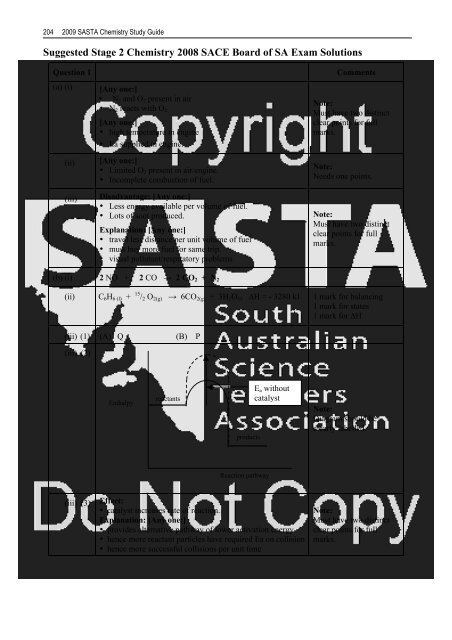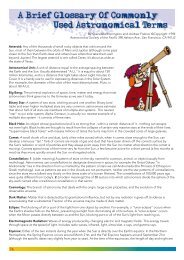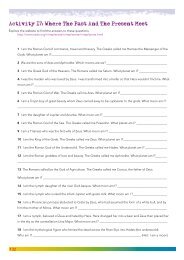Suggested Stage 2 Chemistry 2008 SACE Board of SA Exam ...
Suggested Stage 2 Chemistry 2008 SACE Board of SA Exam ...
Suggested Stage 2 Chemistry 2008 SACE Board of SA Exam ...
You also want an ePaper? Increase the reach of your titles
YUMPU automatically turns print PDFs into web optimized ePapers that Google loves.
204 2009 <strong>SA</strong>STA <strong>Chemistry</strong> Study Guide<br />
<strong>Suggested</strong> <strong>Stage</strong> 2 <strong>Chemistry</strong> <strong>2008</strong> <strong><strong>SA</strong>CE</strong> <strong>Board</strong> <strong>of</strong> <strong>SA</strong> <strong>Exam</strong> Solutions<br />
Question 1 Comments<br />
(a) (i) [Any one:]<br />
• N2 and O2 present in air<br />
• N2 reacts with O2<br />
[Any one:]<br />
• high temperature in engine<br />
• Ea supplied in engine.<br />
(ii) [Any one:]<br />
• Limited O2 present in air/engine.<br />
• Incomplete combustion <strong>of</strong> fuel.<br />
(iii) Disadvantage: [Any one:]<br />
• Less energy available per volume <strong>of</strong> fuel.<br />
• Lots <strong>of</strong> soot produced.<br />
Explanation: [Any one:]<br />
• travel less distance per unit volume <strong>of</strong> fuel<br />
• must buy more fuel for same trip.<br />
• visual pollutant/respiratory problems<br />
(b) (i) 2 NO + 2 CO → 2 CO2 + N2<br />
Note:<br />
Must have two distinct<br />
clear points for full<br />
marks.<br />
Note:<br />
Needs one points.<br />
Note:<br />
Must have two distinct<br />
clear points for full<br />
marks.<br />
(ii) C6H6 (l) + 15 /2 O2(g) → 6CO2(g) + 3H2O(l) ∆H = - 3280 kJ 1 mark for balancing<br />
1 mark for states<br />
1 mark for ΔH<br />
(iii) (1) (A) Q (B) P<br />
(iii) (2)<br />
Enthalpy<br />
reactants<br />
products<br />
Reaction pathway<br />
Ea without<br />
catalyst<br />
(iii) (3) Effect:<br />
• catalyst increases rate <strong>of</strong> reaction.<br />
Explanation: [Any one:]<br />
• provides alternative pathway <strong>of</strong> lower activation energy<br />
• hence more reactant particles have required Ea on collision<br />
• hence more successful collisions per unit time<br />
Note:<br />
Diagram should be<br />
clearly labelled.<br />
Note:<br />
Must have two distinct<br />
clear points for full<br />
marks.
© <strong>SA</strong>STA 2009 <strong>2008</strong> <strong>Exam</strong> Solutions 205<br />
Question 2 Comments<br />
(a) (i)<br />
(ii)<br />
1,2,3 – propanetriol or<br />
propane – 1,2,3 – triol<br />
(iii) (1) increased rate <strong>of</strong> reaction<br />
(iii) (2) Catalyst<br />
Increased temperature<br />
(iii) (3) (A) [Any one:]<br />
Increased melting temperature<br />
More solid<br />
(iii) (3) (B) Becomes more saturated / less unsaturated<br />
(b) (i) Time taken for component to pass through the column..<br />
(c) (i)<br />
(ii) Identification:<br />
Triglyceride 2.<br />
(ii) soap<br />
Explanation – 2 points:<br />
• longer retention time/held for longer time on column<br />
• more strongly adsorbed/attracted/bound to non-polar stationary<br />
phase<br />
[Any three <strong>of</strong>:]<br />
• tail is non-polar<br />
• thus tail dissolves in non-polar oil<br />
• ionic / carboxylate head attracted to polar H2O molecules<br />
• forms micelles with oil droplet in centre<br />
Note:<br />
propan- acceptable.<br />
Eg. propan – 1,2,3 – triol<br />
Note:<br />
Take care when drawing<br />
or copying structures.<br />
Be careful with the<br />
positioning <strong>of</strong> the bonds.<br />
Note:<br />
Needs two points.<br />
Note:<br />
Must have three distinct<br />
clear points for full<br />
marks.<br />
Note:<br />
Annotations on the<br />
diagram acceptable as<br />
long as referred to the<br />
answer.
206 2009 <strong>SA</strong>STA <strong>Chemistry</strong> Study Guide<br />
Question 3 Comments<br />
(a) (i)<br />
(ii)<br />
(b) (i)<br />
(b) (ii) (1)<br />
Mg is more active metal than chromium or<br />
Mg higher in activity series than Cr<br />
Mg reduces Cr 3+ ions or<br />
Mg displaces Cr 3+ ions from solution.<br />
3Mg + 2Cr 3+ → 3Mg 2+ + 2Cr<br />
3CrO4 2− + 2Fe 3+ → Fe2(CrO4)3<br />
pOH = - log[OH − ]<br />
= 5.678<br />
pH = 14 ─ pOH<br />
= 8.3<br />
(2) • As pH increases [H+ ] decreases.<br />
• System adjusts to oppose the change and increase [H + ].<br />
• Thus equilibrium shifts to the left/back reaction is favoured.<br />
Note:<br />
Needs two clear points.<br />
Should refer to metal<br />
activity series given.<br />
Care with terminology.<br />
Note:<br />
1 mark for correct species<br />
1 mark for balancing<br />
Note:<br />
1 mark for correct species<br />
1 mark for balancing<br />
Note:<br />
Should show full working<br />
for calculations.<br />
Note:<br />
Must have three distinct<br />
clear points for full marks.<br />
(c) (i) amphoteric Note:<br />
Not amphiprotic<br />
(ii)<br />
Cr2O3 + 2OH − → 2CrO2 − + H2O<br />
(iii) Non metallic (as it is reacting with OH − )<br />
Note:<br />
1 mark for correct species<br />
1 mark for balancing
© <strong>SA</strong>STA 2009 <strong>2008</strong> <strong>Exam</strong> Solutions 207<br />
Question 4 Comments<br />
(a) (i) Nitrogen or N2 Note:<br />
Name or formula acceptable<br />
(ii) (1) trigonal pyramid<br />
(2) (A) unbonded electron pair on nitrogen atom.<br />
(B)<br />
(b) (i) anaerobic<br />
(c)<br />
(ii) (1) N is a plant nutrient<br />
(2) [Any two <strong>of</strong>:]<br />
• Surface algal growth blocks sunlight from lower algae.<br />
• Plants cannot undergo photosynthesis.<br />
• Thus plants do not produce O2.<br />
• Aerobic decay <strong>of</strong> dead algae uses up oxygen.<br />
Possible equation [Any one <strong>of</strong>:]:<br />
• 2NO + O2 → 2NO2<br />
• NO2 → NO + O<br />
• O + O2 → O3<br />
Increase in ozone [At least one point]:<br />
• NO reacts with atmospheric O2 to form NO2<br />
• NO2 dissociates in the presence <strong>of</strong> sunlight<br />
• NO2 dissociates to form O atoms<br />
• O atoms react with O2 to form O3<br />
• increased number <strong>of</strong> plants results in more NO released and<br />
hence an increase in O3 levels.<br />
Increase undesirable [At least one point]:<br />
• build-up <strong>of</strong> O3 in lower atmosphere leads to the formation <strong>of</strong><br />
photochemical smog<br />
• O3 reacts with hydrocarbons to form a range <strong>of</strong> toxic<br />
chemicals (eg aldehydes, ketones, PAN)<br />
• O3 damages plants/reduces rate <strong>of</strong> photosynthesis/stunts<br />
plant growth<br />
• O3 causes rubber/plastics/paints to deteriorate<br />
• O3 damages skin<br />
• O3 is a respiratory irritant.<br />
Note:<br />
⊕ needs to be next to the<br />
nitrogen atom in the first<br />
diagram.<br />
Note:<br />
Must have two distinct clear<br />
points for full marks.<br />
1. Be careful to answer the<br />
question ie<br />
increase in O3 and<br />
increase undesirable.<br />
2. Plan your answer on<br />
scrap paper before<br />
writing.<br />
3. Marks are allocated for<br />
communication skills<br />
including grammar,<br />
spelling and writing in<br />
sentences.<br />
4. Try for six well<br />
presented points<br />
5. Equations do not need to<br />
be balanced but must<br />
have correct formulae<br />
Do not write your answer<br />
in dot point form unless<br />
you are running out <strong>of</strong><br />
time and it is the only way<br />
you are going to get an<br />
answer down.
208 2009 <strong>SA</strong>STA <strong>Chemistry</strong> Study Guide<br />
Question 5 Comments<br />
(a) (i) C5H8 Note:<br />
Must be molecular<br />
formula<br />
(b)<br />
(c) (i)<br />
(ii) [Any one <strong>of</strong>:]<br />
• Contains a carbon-carbon double bond or<br />
• contains an alkene group<br />
[Any one <strong>of</strong>:]<br />
• monosaccharides are renewable<br />
• more petroleum available to use as chemical feedstock<br />
• carotene molecule is non-polar<br />
• carotene molecule is very large compared to water<br />
• H2O molecule is polar<br />
• non-polar molecules not attracted to / cannot form<br />
H-bonds with polar H2O molecules<br />
(ii) (1) initial colour final colour<br />
β-carotene brown colourless/faded brown<br />
retinal brown colourless/faded brown<br />
(2) [Any one <strong>of</strong>:]<br />
• both contain C=C group / alkene group / are unsaturated<br />
• both undergo an addition reaction<br />
(iii) (1) β-carotene no change/no silver mirror formed<br />
Retinal silver mirror forms<br />
Note:<br />
Must have three distinct<br />
clear points for full<br />
marks.<br />
(2) aldehyde Note:<br />
Must be name; -CHO<br />
formula not acceptable.<br />
(3) oxidation<br />
(4)<br />
Note:<br />
Take care when drawing<br />
or copying structures.<br />
Be careful with the<br />
positioning <strong>of</strong> the bonds.
© <strong>SA</strong>STA 2009 <strong>2008</strong> <strong>Exam</strong> Solutions 209<br />
Question 6 Comments<br />
(a) (i) chemical → electrical<br />
(b) (i)<br />
(ii) (1) 1s 2 2s 2 2p 6 3s 2 3p 6 3d 3 Note:<br />
correct convention<br />
(s, p, d etc and<br />
superscripts)<br />
(iii) (1)<br />
(2) +5 Note:<br />
Sign before digit with<br />
oxidation number<br />
(3) [Any two <strong>of</strong>:]<br />
• oxidation no. <strong>of</strong> V decreases<br />
• electrons are gained<br />
• reduction occurs<br />
(4) (arrow marked on the diagram) Note:<br />
Arrow must be in /<br />
near external circuit.<br />
electrolytic cell<br />
(2) V2+ or<br />
vanadium(II) ion<br />
• zeolite consists <strong>of</strong> a continuous network <strong>of</strong><br />
strong/primary/ionic/covalent bonds<br />
• a large amount <strong>of</strong> energy is needed to overcome these strong<br />
bonds<br />
(ii) (1) [Al2Si10O24] 2−<br />
(2)<br />
[Any one <strong>of</strong>:]<br />
• Al is (covalently) bonded within the lattice network.<br />
• Al has substituted for silicon within the lattice network.<br />
• Na and Ca ions are adsorbed/stuck/attracted to the surface <strong>of</strong><br />
the zeolite; Al is not.<br />
Note:<br />
Not vanadium ion as<br />
not specific enough<br />
Note:<br />
Must be adsorbed<br />
not absorbed.
210 2009 <strong>SA</strong>STA <strong>Chemistry</strong> Study Guide<br />
Question 7 Comments<br />
(a) (i)<br />
(ii)<br />
(b) (i)<br />
[Any three <strong>of</strong>:]<br />
• Al 3+ very small and highly charged/high charge density<br />
• attract negatively charged clay particles (& other suspended<br />
matter)<br />
• Al 3+ forms Al(OH)3 gel trapping suspended matter<br />
• large floc/aggregate/clump forms and settles to the bottom<br />
[Any one <strong>of</strong>:]<br />
• clearer<br />
• improves clarity<br />
• floc settles to the bottom<br />
• can be filtered<br />
(iii) (1) Al2O3 + 6H + → 2Al 3+ + 3H2O<br />
(2) [Any one <strong>of</strong>:]<br />
• H + exchanges with/displaces Al 3+ on clay surfaces<br />
• cation exchange occurs<br />
• HClO is an oxidiser<br />
• kills bacteria/sterilises the water<br />
(ii) (1) 2Cl − → Cl2 + 2e −<br />
(2) + electrode<br />
(3) Explanation:<br />
• less energy needed to reduce H2O than Na +<br />
What produced:<br />
• H2O is reduced at the cathode / H2 produced at the cathode<br />
(4) [Any one <strong>of</strong>:]<br />
• molten NaCl (or another sodium ionic compound)<br />
• molten sodium compound<br />
Note:<br />
Must have three<br />
distinct clear points<br />
for full marks.<br />
Note:<br />
Needs two points.<br />
Note:<br />
Needs two points.<br />
Note:<br />
Needs molten.<br />
Not molten salt (all<br />
ionic compounds are<br />
salts)
© <strong>SA</strong>STA 2009 <strong>2008</strong> <strong>Exam</strong> Solutions 211<br />
Question 8 Comments<br />
(a)<br />
(b) (i)<br />
(ii) (1) [Any two <strong>of</strong>:]<br />
• Enzyme chain gains energy.<br />
• Hydrogen bonds/ion-dipole and dispersion forces are<br />
overcome.<br />
• The 3-D shape <strong>of</strong> the enzyme will change.<br />
Must mention:<br />
• If the structure <strong>of</strong> the enzyme changes then it is unable to<br />
carry out its biological function.<br />
(ii) (2)(A) CO2 + H2O → H2CO3<br />
(B)<br />
CO2 + H2O H2CO3<br />
Acidic or<br />
low pH<br />
(c) (ii) (1) 0.21 – 0.23<br />
(ii)<br />
(2) ppb = µg/L<br />
no. µg Cd = 3.5 x 0.010<br />
(3) ppb = µg/kg<br />
= 0.035 µg<br />
= = 0.035/0.00045 = 77.7777<br />
= 78 ppb (2 sf)<br />
[Any two <strong>of</strong>:]<br />
• Cd lamp is used<br />
• wavelength used is absorbed only by Cd<br />
• Na absorbs a different wavelength/does not absorb this<br />
wavelength<br />
Note:<br />
Take care when drawing<br />
or copying structures.<br />
Be careful with the<br />
positioning <strong>of</strong> the bonds.<br />
Note:<br />
Section <strong>of</strong> molecule<br />
therefore open at least<br />
one end or both.<br />
Note:<br />
Must have three distinct<br />
clear points for full<br />
marks.<br />
Note:<br />
1 mark for correct<br />
species<br />
1 mark for balancing<br />
Note:<br />
Should show full<br />
working for calculations.<br />
Note:<br />
Should show full<br />
working for calculations.<br />
Note:<br />
Must have two distinct<br />
clear points for full<br />
marks.<br />
(iii) Has non zero absorbance for zero concentration <strong>of</strong> cadmium. Note:<br />
Not does not start at zero
212 2009 <strong>SA</strong>STA <strong>Chemistry</strong> Study Guide<br />
Question 9 Comments<br />
(a) NO (Regenerated in Step 4 and used in Step 2) Note:<br />
Name or formula.<br />
(b) Reason: Advantage:<br />
More product produced Thus more cost effective.<br />
per unit time.<br />
or<br />
Increased rate at lower Thus save on energy.<br />
temperatures.<br />
(c)<br />
(d) (i)<br />
(e)<br />
Effect:<br />
• Increases yield <strong>of</strong> NO2.<br />
Explanation [Any two <strong>of</strong>]:<br />
• System adjusts to oppose the high pressure.<br />
• Thus favours reaction that forms fewer moles <strong>of</strong> gas<br />
particles.<br />
• Favours forward reaction/equilibrium shifts to the right.<br />
Kc =<br />
(ii) (1) 2NO2(g) N2O4(g)<br />
(2)<br />
(3)<br />
initial moles 0.132 0<br />
attaining eq m 0.0800 0.0400<br />
at equilibrium (0.132 – 0.0800) 0.0400<br />
Kc =<br />
=<br />
=<br />
= 14.79<br />
= 0.0520<br />
Reaction: Exothermic<br />
Explanation [Any two <strong>of</strong>]:<br />
• Kc decreases as temperature increases<br />
• there are less products and more reactants<br />
• the reverse reaction is endothermic<br />
Fe + 2H + → H2 + Fe 2+ or<br />
2Fe + 6H + → 3H2 + 2Fe 3+<br />
Note:<br />
Advantage must<br />
correspond with reason<br />
Note:<br />
Must have three distinct<br />
clear points for full marks.<br />
Note:<br />
Should show full working<br />
for calculations.<br />
Note:<br />
Must have three distinct<br />
clear points for full marks.<br />
Note:<br />
Must be ionic equation<br />
1 mark for correct species<br />
1 mark for balancing
© <strong>SA</strong>STA 2009 <strong>2008</strong> <strong>Exam</strong> Solutions 213<br />
Question 10 Comments<br />
(a) (i) 6CO2 + 24H + + 24e − → C6H12O6 + 6H2O Note:<br />
1 mark for correct species<br />
1 mark for balancing<br />
(b) (i)<br />
(ii) n(CO2) =<br />
n(C6H12O6) = x n(CO2)<br />
= x<br />
Energy required = 2820 x x<br />
= 10 679 kJ<br />
Note:<br />
Should show full working for<br />
calculations.<br />
(iii) (1) C6H12O6 → 2C2H5OH + 2CO2 Note:<br />
1 mark for correct species<br />
1 mark for balancing<br />
(2) • Yeasts provide enzymes.<br />
• Enzymes increase the rate <strong>of</strong> reaction.<br />
(3) CO2 released is balanced by CO2 absorbed during<br />
photosynthesis.<br />
(ii) (1) ester<br />
[Any two <strong>of</strong>:]<br />
• HCO3 − is basic<br />
• neutralises H +<br />
• removes/lowers concentration <strong>of</strong> H +<br />
Note:<br />
Must have two distinct clear<br />
points for full marks.<br />
Note:<br />
Must have two distinct clear<br />
points for full marks.<br />
(2) (A) CH3OH or methanol Note:<br />
Name or formula<br />
(B) • carboxylate ion forms (actually 2 carboxylate ions)<br />
• ion-dipole forces between ion and water<br />
• weaker dipole-dipole forces between chlorophyll<br />
molecule and water.<br />
Note:<br />
Must have three distinct clear<br />
points for full marks.
214 2009 <strong>SA</strong>STA <strong>Chemistry</strong> Study Guide<br />
Question 11 Comments<br />
(a) (i) d-block<br />
sig fig 3 sig figs must be used for answer in (a)<br />
(ii) n = C.V<br />
= 0.0100 x 0.250<br />
= 0.00250<br />
m = n.M<br />
= 0.00250 x 433.026<br />
= 1.082565<br />
= 1.08 g (3 sf)<br />
(iii) (1) n = C.V<br />
= 0.0100 x 0.01786<br />
= 1.786 x 10 −4<br />
= 1.79 x 10 −4 (3 sf)<br />
(2) n(F − ) = 3n(La 3+ )<br />
= 3 x 1.786 x 10 −4<br />
= 5.358 x 10 −4<br />
= 5.36 x 10 −4 (3 sf)<br />
(3) m = n.m<br />
= 5.358 x 10 −4 x 41.99<br />
= 0.022498….<br />
= 0.0225 g<br />
= 22.5 mg (3 sf)<br />
(4) % = x 100<br />
(5) Increased.<br />
= 4.4996<br />
= 4.50% (3 sf)<br />
(b) mg needed = 5 x 0.95<br />
(c) (i)<br />
∴ no. tablets needed = = 3.96<br />
Thus need 4 tablets.<br />
That the solubility <strong>of</strong> F − / % <strong>of</strong> F − soluble in water<br />
decreases as water hardness increases.<br />
(ii) Data from graph [Any one]:<br />
• water hardness increases from 0 – 200<br />
• F − changes 100 – 90%<br />
Comment[Any one]:<br />
• most F − still available<br />
• minor reduction<br />
Note:<br />
Full working for<br />
calculations should be<br />
shown.<br />
Units not necessary as<br />
stated in question<br />
Note:<br />
Must use data from graph<br />
and comment for full marks
© <strong>SA</strong>STA 2009 <strong>2008</strong> <strong>Exam</strong> Solutions 215<br />
Question 12 Comments<br />
(a) (i) (1) Condensation<br />
(b)<br />
(c) (i)<br />
(2) 1 mark for any one <strong>of</strong>:<br />
• small molecule/H2O eliminated/lost during reaction<br />
• mass <strong>of</strong> polymer chain less than total mass <strong>of</strong><br />
monomer used<br />
• reaction between carboxylic acid and amine<br />
(ii) (1) (1) amide<br />
(2)<br />
(3) 1 mark for any one <strong>of</strong>:<br />
• small molecule/H2O not eliminated during reaction<br />
• mass <strong>of</strong> polymer chain = total mass <strong>of</strong> monomer used<br />
1,6 – hexanedioic/hexandioic acid or<br />
hexanedioic/hexandioic acid<br />
1 mark for any one <strong>of</strong>:<br />
• the polymers consist <strong>of</strong> chains <strong>of</strong> different length/not<br />
all chains are the same length<br />
• some monomer remains<br />
• contaminants or additives may be present<br />
(ii) 1 mark for:<br />
• Stanyl s<strong>of</strong>tens at higher temperature than other two<br />
polymers.<br />
1 mark for:<br />
• PP non-polar<br />
• dispersion forces only between PP chains<br />
• little energy needed to overcome weak interactions<br />
between PP chains<br />
• Nylon 6/Stanyl contain polar amide group<br />
• hydrogen bonding between Nylon 6/Stanyl chains<br />
• stronger forces between/higher temperatures needed<br />
to overcome forces between Nylon 6/Stanyl chains<br />
than PP chains<br />
• shorter non-polar segments in Stanyl chains than<br />
Nylon 6 chains<br />
• more amide groups/hydrogen bonds per unit length <strong>of</strong><br />
polymer chain in Stanyl than Nylon 6<br />
1. Be careful to answer<br />
the question ie<br />
Which polymer<br />
2. Plan your answer on<br />
scrap paper before<br />
writing.<br />
3. Marks are allocated for<br />
communication skills<br />
including grammar,<br />
spelling and writing in<br />
sentences.<br />
4. Try for six well<br />
presented points<br />
Do not write your answer<br />
in dot point form unless<br />
you are running out <strong>of</strong><br />
time and it is the only way<br />
you are going to get an<br />
answer down.








